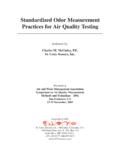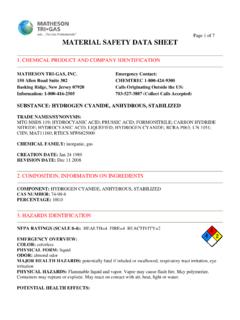Transcription of HRESHOLD ODOR NUMBER (TON) CALCULATIONS
1 THRESHOLD ODOR NUMBER (TON) CALCULATIONS . Threshold Odor Numbers are whole numbers that indicate how many dilutions it takes to produce odor-free water. As described in Standard Methods for the Examination of Water and Wastewater, the test involves two steps. Step one is used to determine the range of dilutions for the final test. Add the following amounts of sample water to four 500 mL flasks: 200 mL, 50 mL, 12 mL, and mL. Add enough odor-free water to the flasks to create a total volume of 200 mL. Also, prepare another flask filled with only odor-free water. Heat the flasks to 40-60 C and shake. Smell each flask, starting with the odor-free water, then proceeding from lowest to highest concentration of sample water. Prepare flasks for the final test according to the volume of sample in the jar that first has a detectable odor.
2 ML Intermediate dilution 12 mL 12 mL, mL, mL, mL, and mL. 50 mL 50 mL, 35 mL, 25 mL, 17 mL, and 12 mL. 200 mL 200 mL, 140 mL, 100 mL, 70 mL, and 50 mL. Add the amounts of sample water indicated to five 500 mL flasks. Next, add odor-free water to bring each flask to a total volume of 200 mL. Include two blanks (flasks with 200 mL of odor-free water) in the series of samples near the expected threshold for a total of seven samples. Have a group of testers smell each flask, beginning with the smallest concentration of sample water. Record the volume of sample water in the first flask an odor is detected by each tester. Compute the TON using this equation: A +B. Threshold Odor NUMBER =. A. where A = the volume of sample water and B = the volume of odor-free water. Since A.
3 + B is always going to equal 200 mL, the calculation can be restated as: 200 mL. Threshold Odor NUMBER =. Sample Volume, mL. Find the TON when odor is first detected in a flask containing 50 mL of sample water. 200 ml Threshold Odor NUMBER =. Sample Volume, ml 200 ml =. 50 ml = 4 TON. THRESHOLD ODOR NUMBER CALCULATIONS (CONT.). Usually a NUMBER of testers are involved in determining odor for a particular sample due to the fact that people's olfactory senses are not uniform. Instead of finding the arithmetic mean (average) of different TON values, the geometric mean is calculated. The formula for this process is: Geometric Mean = (X1 X 2 X 3 .. X n ) 1 n In this formula, each X value is a TON and n is the total NUMBER of TON values. An example of this type of exam problem would be: A series of CALCULATIONS have produced the following TON values: , 3, 2, 2, 1, and 1.
4 What is the geometric mean of these numbers? A) 18. B) C) D) And the answer is C) Here is the solution. Let X1 = , X2 = 3, X3 = 2, X4 = 2, X5 = 1, and X6 = 1. Since there are 6 values, n = 6. Using the formula, Geometric Mean = ( X 1 X 2 X 3 .. X n ) 1. n = ( 3 2 2 1 1 ). 1. 6. = (18 ) = NOTE: Performing geometric mean computations requires a calculator with a [yx] or [xy] key. At Water Opcert School we encourage every water operator to own and be skilled in the use of a basic scientific calculator. If you would like assistance with either purchasing a calculator or understanding how to use the functions needed for water math applications, please contact Water Opcert School.





